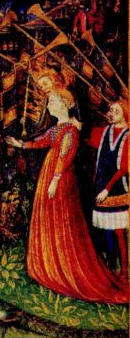Ferrara 1441
| A new document was detected in March 2003, perhaps relating to the first appearance of a 5x14-deck with 14 "Trionfi" (figure) as a 5th suit. It might cause a revolution in playing card research. In our studies around the 5x14-theory Ross Gregory Caldwell discovered in March 2003 a strange entry in the Ferrarese account books: At the 1st of January of 1441 the painter Sagramoro got money for having painted "14 figure" (14 figures) on a special paper (which was also in use for the production of playing cards), which were intended for an unspecified use at a "party at night" for the guest Bianca Maria Visconti, 15-years-old single daughter of the duke of Milano Filippo Maria Visconti, who is well known for his interests in the production of unusual playing-card decks. The entry alarmed us. "14" was the "right" number, and we were searching for better evidence for the 5x14-theory .... however, in the entry an expression like "playing cards" or "ludus triumphorum" or "Trionfi" was missing. What was the object, for which Sagramoro was paid? What paintings could be of use for a "party at night"? Our research did begin ... What's so alarming in this entry?
Well, the missing of the term "Trionfi " is not surprizing or illogical. A deck can exist without having a specific name, in many other examples first an invention is done and the name to the object is given later. As the name of "Trionfi" in relation to a playing card deck first appears in February 1442 (as far as we know) the missing of the name in January 1441 doesn't mean a contradiction. It might just indicate, that that, what is produced in January 1441 has the character of an invention ... The Invention of Tarot? No, only the invention of the 5x14-deck including 14 "special figures", just that, what later became the major Trionfi-version for a longer time, perhaps already intended to play the role of a 5th predefined trump-suit. Is the missing of the words "playing cards" a contradiction? No, not really. If it really was an "innovative situation" at that evening of 1st of January 1441 or around that time, then perhaps Sagramoro only made projecting paintings, just being on their way to become Tarot cards later. Or the words "playing cards" are just not written ... perhaps, cause these "14 figure" had been strange playing cards, until then unknown objects, so it was near to the writer in the account book to speak of "14 figure" instead of "playing cards". Why "14 figure", why not 70 cards? The Este had already playing cards of the usual kind, they only needed to add 14 Trionfi cards to update an already existing deck. Why just Bianca Maria Visconti? The situation is logical ... As one of possibly not many persons just Bianca Maria "must" have known the playing cards experiments of her father, at least the Michelino deck, which was produced before 1425. We don't know the date of the Cary-Yale Tarocchi, perhaps it did already exist or it didn't exist. In the case, that Bianca Maria - a 15 years-old-girl in her first situation of a public appearance at a foreign court as an honoured guest - told in her communications at the Ferrarese court of the interesting decks of her father, this might have induced her host, Leonello (in this special case - an interesting political situation - a possible husband-in-spe), to please the guest with a production of his own in the same field, intended as "a present for the guest" or as a "sign of love" or similar. We researched the case, turning any stone, that we did see around the date and the location, Ferrara 1441 ...Our results you can visit here, still a little unfinished, as it is a situation "in research". A final security, if the 5x14-deck was just invented at this occasion, was not possible to reach - but, we're rather near to a rather good story. "Leonello invented the 5x14-deck cause of love to Bianca Maria", or "three young girls designed the early Tarot", this are possible conclusions ... but, of course, not with 100 % security, just ideas to settle the various informations into a shape. Anyway, an interesting object ... (autorbis) |
  |
Lay-Out composed by Dieter Maas / autorbis.
Copyright: Trionfi.com/autorbis